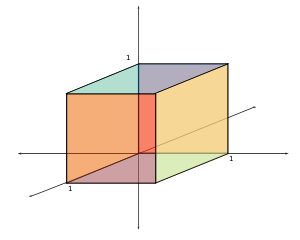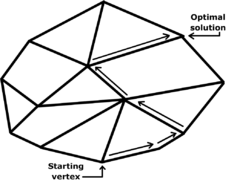
Klee–Minty cube
Encyclopedia

Unit cube
A unit cube, sometimes called a cube of side 1, is a cube whose sides are 1 unit long. The volume of a 3-dimensional unit cube is 1 cubic unit, and its total surface area is 6 square units.- Unit Hypercube :...
whose corners have been slightly perturbed. Klee and Minty demonstrated that Dantzig's simplex algorithm
Simplex algorithm
In mathematical optimization, Dantzig's simplex algorithm is a popular algorithm for linear programming. The journal Computing in Science and Engineering listed it as one of the top 10 algorithms of the twentieth century....
has poor worst-case performance when initialized at one corner of their "squashed cube".
In particular, many optimization algorithm
Algorithm
In mathematics and computer science, an algorithm is an effective method expressed as a finite list of well-defined instructions for calculating a function. Algorithms are used for calculation, data processing, and automated reasoning...
s for linear optimization
Linear programming
Linear programming is a mathematical method for determining a way to achieve the best outcome in a given mathematical model for some list of requirements represented as linear relationships...
exhibit poor performance when applied to the Klee–Minty cube. In 1973 Klee and Minty showed that Dantzig's simplex algorithm
Simplex algorithm
In mathematical optimization, Dantzig's simplex algorithm is a popular algorithm for linear programming. The journal Computing in Science and Engineering listed it as one of the top 10 algorithms of the twentieth century....
was not a polynomial-time algorithm when applied to their cube. Later, modifications of the Klee–Minty cube have shown poor behavior both for other basis
Matroid
In combinatorics, a branch of mathematics, a matroid or independence structure is a structure that captures the essence of a notion of "independence" that generalizes linear independence in vector spaces....
-exchange pivoting algorithms and also for interior-point algorithms.
Description of the cube
The Klee–Minty cube was originally specified with a parameterized system of linear inequalities, with the dimension as the parameter. When the dimension is two, the "cube" is a squashed square. When the dimension is three, the "cube" is a squashed cube. Illustrations of the "cube" have appeared besides algebraic descriptions.Computational complexity
The Klee–Minty cube has been used to analyze the performance of many algorithms, both in the worst case and on average. The time complexityTime complexity
In computer science, the time complexity of an algorithm quantifies the amount of time taken by an algorithm to run as a function of the size of the input to the problem. The time complexity of an algorithm is commonly expressed using big O notation, which suppresses multiplicative constants and...
of an algorithm
Algorithm
In mathematics and computer science, an algorithm is an effective method expressed as a finite list of well-defined instructions for calculating a function. Algorithms are used for calculation, data processing, and automated reasoning...
counts the number of arithmetic operations sufficient for the algorithm to solve the problem. For example, Gaussian elimination
Gaussian elimination
In linear algebra, Gaussian elimination is an algorithm for solving systems of linear equations. It can also be used to find the rank of a matrix, to calculate the determinant of a matrix, and to calculate the inverse of an invertible square matrix...
requires on the order of D3 operations, and so it is said to have polynomial time-complexity, because its complexity is bounded by a cubic polynomial. There are examples of algorithms that do not have polynomial-time complexity. For example, a generalization of Gaussian elimination called Buchberger's algorithm
Buchberger's algorithm
In computational algebraic geometry and computational commutative algebra, Buchberger's algorithm is a method of transforming a given set of generators for a polynomial ideal into a Gröbner basis with respect to some monomial order. It was invented by Austrian mathematician Bruno Buchberger...
has for its complexity an exponential function of the problem data (the degree of the polynomial
Degree of a polynomial
The degree of a polynomial represents the highest degree of a polynominal's terms , should the polynomial be expressed in canonical form . The degree of an individual term is the sum of the exponents acting on the term's variables...
s and the number of variables of the multivariate polynomials). Because exponential functions eventually grow much faster than polynomial functions, an exponential complexity implies that an algorithm has slow performance on large problems.
Worst case

Computational Complexity
Computational Complexity may refer to:*Computational complexity theory*Computational Complexity...
complexity
Time complexity
In computer science, the time complexity of an algorithm quantifies the amount of time taken by an algorithm to run as a function of the size of the input to the problem. The time complexity of an algorithm is commonly expressed using big O notation, which suppresses multiplicative constants and...
of many algorithm
Algorithm
In mathematics and computer science, an algorithm is an effective method expressed as a finite list of well-defined instructions for calculating a function. Algorithms are used for calculation, data processing, and automated reasoning...
s of linear optimization. It is a deformed cube
Unit cube
A unit cube, sometimes called a cube of side 1, is a cube whose sides are 1 unit long. The volume of a 3-dimensional unit cube is 1 cubic unit, and its total surface area is 6 square units.- Unit Hypercube :...
with exactly 2D corners in dimension
Dimension (vector space)
In mathematics, the dimension of a vector space V is the cardinality of a basis of V. It is sometimes called Hamel dimension or algebraic dimension to distinguish it from other types of dimension...
D. Klee and Minty showed that the Dantzig's
George Dantzig
George Bernard Dantzig was an American mathematical scientist who made important contributions to operations research, computer science, economics, and statistics....
simplex algorithm
Simplex algorithm
In mathematical optimization, Dantzig's simplex algorithm is a popular algorithm for linear programming. The journal Computing in Science and Engineering listed it as one of the top 10 algorithms of the twentieth century....
visits all of a (perturbed) cube
Unit cube
A unit cube, sometimes called a cube of side 1, is a cube whose sides are 1 unit long. The volume of a 3-dimensional unit cube is 1 cubic unit, and its total surface area is 6 square units.- Unit Hypercube :...
in dimension D in the worst case.
Modifications of the Klee–Minty construction showed similar exponential time complexity
Time complexity
In computer science, the time complexity of an algorithm quantifies the amount of time taken by an algorithm to run as a function of the size of the input to the problem. The time complexity of an algorithm is commonly expressed using big O notation, which suppresses multiplicative constants and...
for other pivoting rules of simplex type, which maintain primal feasibility, such as Bland's rule
Bland's rule
In mathematical optimization, Bland's rule is an algorithmic refinement of the simplex method for linear optimization....
. Another modification showed that the criss-cross algorithm
Criss-cross algorithm
In mathematical optimization, the criss-cross algorithm denotes a family of algorithms for linear programming. Variants of the criss-cross algorithm also solve more general problems with linear inequality constraints and nonlinear objective functions; there are criss-cross algorithms for...
, which does not maintain primal feasibility, also visits all the corners of a modified Klee–Minty cube. Like the simplex algorithm, the criss-cross algorithm visits all 8 corners of the three-dimensional cube in the worst case.
Path-following algorithms
Further modifications of the Klee–Minty cube have shown poor performance of central-path–following algorithms for linear optimization, in that the central path comes arbitrarily close to each of the corners of a cube. This "vertex-stalking" performance is surprising, because such path-following algorithms have polynomial-time complexity for linear optimization.Average case
The Klee–Minty cube has also inspired research on average-case complexityAverage-case complexity
Average-case complexity is a subfield of computational complexity theory that studies the complexity of algorithms on random inputs.The study of average-case complexity has applications in the theory of cryptography....
. When eligible pivots are made randomly (and not by the rule of steepest descent), Dantzig's simplex algorithm needs on average
Expected value
In probability theory, the expected value of a random variable is the weighted average of all possible values that this random variable can take on...
quadratically
Quadratic polynomial
In mathematics, a quadratic polynomial or quadratic is a polynomial of degree two, also called second-order polynomial. That means the exponents of the polynomial's variables are no larger than 2...
many steps (on the order of O(D2).
Standard variants of the simplex algorithm takes on average D steps for a cube. When it is initialized at a random corner of the cube, the criss-cross algorithm visits only D additional corners, however, according to a 1994 paper by Fukuda and Namiki. Both the simplex algorithm and the criss-cross algorithm visit exactly 3 additional corners of the three-dimensional cube on average.
See also
- Projective algorithm of KarmarkarKarmarkar's algorithmKarmarkar's algorithm is an algorithm introduced by Narendra Karmarkar in 1984 for solving linear programming problems. It was the first reasonably efficient algorithm that solves these problems in polynomial time...
- Ellipsoidal algorithm of Khachiyan
Algebraic description with illustration
The first two links have both an algebraic construction and a picture of a three-dimensional Klee–Minty cube:System of linear inequalities with no picture
- Greenberg, Harvey J., Klee-Minty Polytope Shows Exponential Time Complexity of Simplex Method University of Colorado at Denver (1997) PDF download
Pictures with no linear system
- A picture of a Klee-Minty cube and a dynamic animation tracing the path of an algorithm (with no accompanying text) at the homepage of Eissa Nematollahi A static but publication-quality version is available at the publisher's website.
- A picture of a Klee-Minty cube showing a simplex-algorithm path, by Günter Ziegler. The picture is after the middle of the page.

